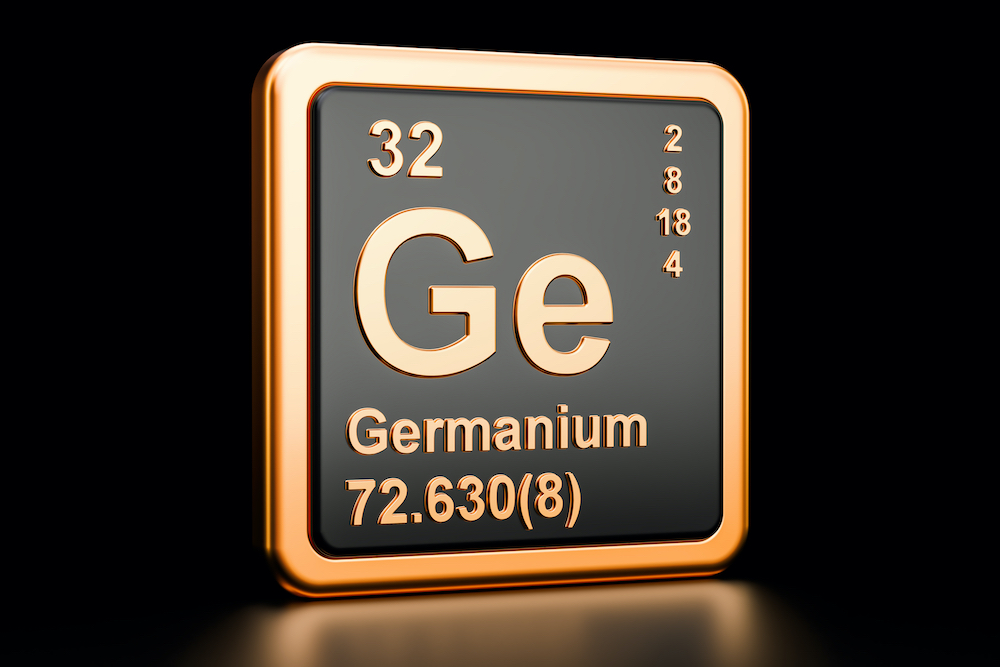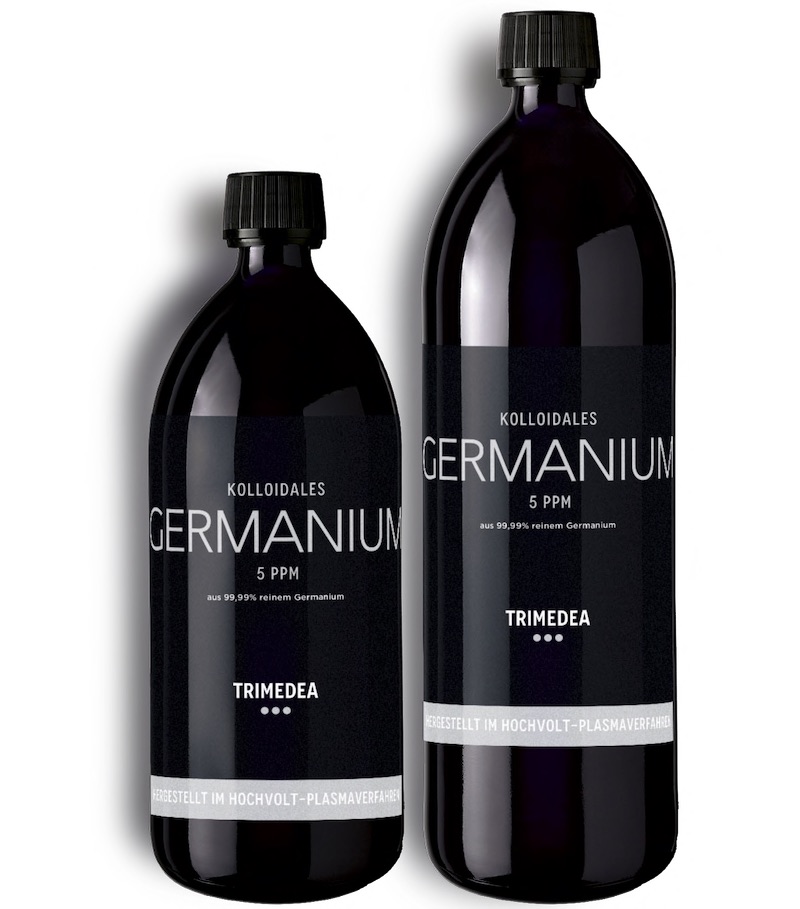Helpful and forbidden: What is behind this metal?
From our series: Colloidal metals
Colloidal germanium is different! On the one hand, organic germanium is the subject of many reports about healing successes; it is praised as a very special metal. On the other hand, its sale is forbidden by the authorities, since it can be toxic as inorganic germanium at high doses.
As is so often the case, the truth lies in the middle: It depends on the compound. Because we do not take the pure element to us, it is always germanium compounds.
In nature, the elements found on and in the earth are brought into solution. For many elements this is easy – but there are also chemical elements for which this is very difficult or the concentrations in the solutions are very low. Decisive for this is the lattice energy of elements/metals and their reactivity. As with us humans, there are also reactive and less reactive elements in metals. And this has influence on the relationship and connection to others.
Germanium and germanium compounds
Whether an element is useful or harmful in the body therefore depends on the compound and the quantity used. There is a lot of truth in statements like “the quantity makes the poison”. In addition to the quantity, the combination of the metal with other elements also plays a decisive role when it comes to benefit or harm.
Differences between organic germanium and inorganic germanium
Organic germanium occurs as a compound with carbon – inorganic without carbon. The latter is harmful to the body and can cause serious side effects when ingested.
Inorganic germanium compounds that can be deposited in the body and are toxic above a certain level:
- Germaniumdioxid
- Germaniumtetrachlorid
- Germaniumiodid
- Germaniumhydrid
- Germaniumzitratlaktat*
*the germanium atom is not directly connected with carbon but with oxygen, therefore it is an inorganic compound and not, as often wrongly claimed, an organic compound
In contrast, organic germanium and its compounds are water-soluble and are thus excreted in the urine. In Japan, it is a well-known and recognized remedy for a variety of ailments.
Important: Reports on side effects and “toxicity” refer exclusively to inorganic compounds.
Important milestones in research
- 1871: The Russian chemist Dmitri Mendeleev drafts the periodic table and suspects that there is an element with the properties of germanium, but this had not yet been proven
- 1886: The German chemist Clemens Winkler proves germanium for the first time in Freiberg. Hence the name (lat. Germania = Germany)
- 1945: Japanese Dr. Kazuhiko Asai establishes a foundation for coal research in Japan
- 1952: Dr. Asai discovers the element in some medicinal plants, which is why he assumes a health effect
- 1966: Russian chemist Dr. V. Mironov is the first to discover organic germanium
- 1967: Dr. Asai and his team succeed in producing the organic compound carboxyethylgermanium sesquioxide
- 1968: Dr. Asai establishes the Asai Germanium Research Institute and a germanium clinic in Kawasaki, Japan
Dr. Asai was the first researcher to extract organic germanium from inorganic germanium. This laid the foundation for his clinic in Japan and the associated research institute, where research on the subject continues to this day. After his death, the clinic was closed.
Germanium sesquioxide is best researched
There are a variety of organic germanium compounds, the best known and studied being Carboxyethylgermanium-Sesquioxide.
The safety of this compound has been confirmed very often. This is also the compound that Dr. Asai synthesized at that time. That is why it is also called Asaigermanium in Japan. It is further known by the following names:
-
- β -Bis-Carboxyethylgermanium sesquioxide (chemical name)
- 2-carboxyethylgermanium sesquioxide (chemical name)
- poly- trans -[(2-carboxyethyl) germasesquioxane] (chemical name)
- Ge-132 (Entwicklungsnummer im Forschungsinstitut from Dr. Asai)
- Repagermanium (name used internationally)
Germanium in nature
In organic and inorganic compounds, it occurs in zinc ores, coal, germanite and other minerals. It is mainly obtained as a by-product in the coal, zinc and aluminum industries. The element occurs worldwide, but is mined mainly in China, Russia and the USA.
The metal is also found in many foods, usually only in minute traces. Plants have the ability to draw germanium from the soil and enrich it. Animals eat plants, enrich and concentrate more and more of it, and thus it enters our bodies through our plant food or meat.
Some plants contain relatively high levels of germanium, such as goji berries, ginseng, shiitake mushrooms, aloe vera, and garlic. These plants are commonly used in natural medicine, including traditional Chinese medicine. The germanium content of plants naturally varies depending on how much of the metal is present in the soil. Therefore, no fixed value can be determined.
The German Federal Institute for Risk Assessment assumes that humans absorb about 1.5 mg of germanium daily through food. How much of this is bioavailable for metabolism and used can only be estimated.
Effects of organic germanium
-
- antioxidant
- detoxifying
- analgesic
- anti-inflammatory
- activates the immune system, especially T-cells, macrophages, neutrophils,
- lymphokines and interferons
- increases oxygen utilization, energy production in cells/organs
- improves blood circulation and microcirculation
- helps in binding and excretion of heavy metal compounds
Range of application for organic germanium
-
- Osteoporosis
- Improvement of blood flow properties (viscosity)
- Rheumatoid arthritis
- Arteriosclerosis and related cardiovascular diseases
- Stroke
- Eye diseases (glaucoma, cataract, retinal detachment, etc.)
- Lung diseases, asthma, bronchitis, emphysema
- Depression
Colloidal germanium is neither inorganic nor organic germanium
As a suspended colloid, it reaches and acts in the body in its purest form, with particle sizes of 1 – 20nm. Produced in the high-voltage plasma process, the tiny germanium colloids pass through the oral mucosa or intestines into the blood and from there to the organs and cells. Colloidal germanium does not deposit in tissues, does not form compounds with other elements, has no side effects, and is overdose-free. Colloidal germanium by Trimedea remains in the body for days or weeks, as long as it is energetically charged and needed in the metabolism. Application and dosage of colloidal germanium can be found here.
Side effects of organic germanium
In Europe, four cases are known in which ingestion of germanium citrate lactate led to renal failure and then death. Doses varied from 25 to 47 g daily over a period of 2 to 30 months. Germanium citrate lactate is often labeled organic, but is actually an inorganic germanium.
According to Dr. Asai, taking Carboxyethylgermanium-Sesquioxide can cause diarrhea when too intense detoxification and elimination processes are activated in the body. Usually, the symptoms are over after 3 to 14 days.


